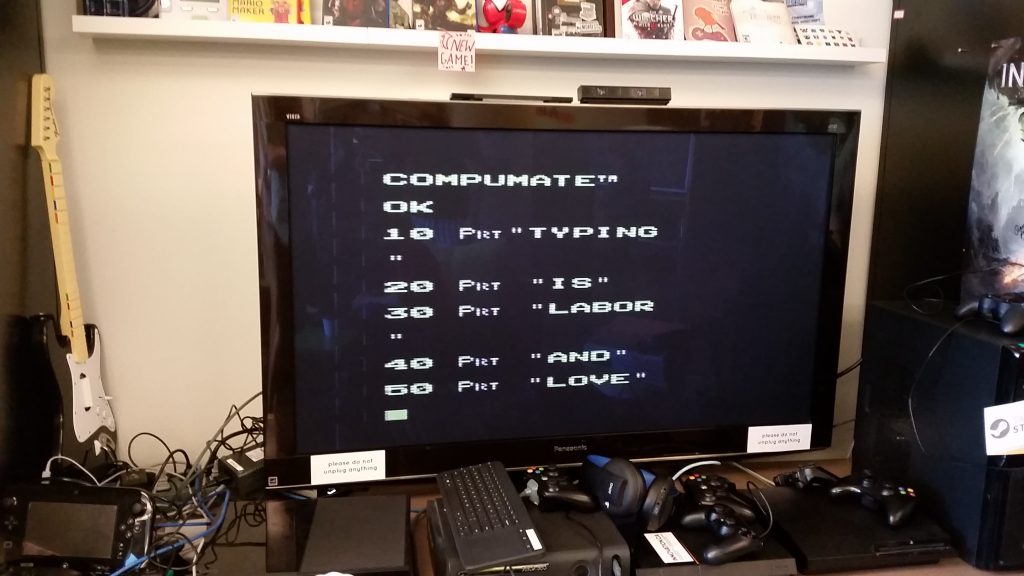The Atari 2600 and the Search for Removable Memory
by Kyle Bickoff
Hi all, let me apologize for my late posting on Day 3—I felt quite poorly after class so am putting this up a day late. Here it is:
Today I’m thinking about what exactly the vintage computers I’m using are helping me to reveal, particularly in regards to my topics of interest: memory, infrastructure, and the blackbox.
I worked today with the Atari 2600, specifically, connected to the Spectravision Compumate. Rather than simply inserting a traditional cartridge and connecting a controller via serial port—this cartridge first inserts, and then has three different cables connecting—two of which insert into the controller ports and the third of which leads to the Spectravision keyboard. I’ve never used such a system before—since reading about it I’ve discovered that while the company was originally called “Spectravision,” it was forced to rename to “Spectravideo” after a TV hotel system claimed the former name was previously taken (fun factoid)—it only caused me some minor confusion at first.
So, I’d like to compare my experience with the Spectravision in relation to my experience with the NES modding. First, let me explain that the manual for the Spectravision suggests that both a removable magnetic tape drive, as well as a removable hard drive are available for sale to connect to the Spectravision. After talking with Patrick, he’s suggested that neither of the products may have ever been made, and that it may have just been an option that the company was considering at the time and chose to print on the warranty registration form for this unit. I’ve looked up both devices and I’ve found that Spectravision does hold some patents for magnetic tape drive editing systems—but I’ve found no hard drive related information or patents whatsoever. I’m going to assume at this point that there’s not any hardware that was produced at the time, 1981, that might have exported this content. Still, while I didn’t plan for this result, there remain multiple ways to ‘save’ Spectravision content: one can use save slots within the Spectravision unit to hold files, edit them, stop work, and resume work, so long as it is saved inside of the powered-on unit. Second, I am going to assume that since the unit supports BASIC, it may well support the possibility to write to external media.. (Side note: I wrote a little program, which displays the image shown below.)

Artist’s Statement: If you’re in our class, you’ll observe the nod to Nakamura, as well as our discussion of neoliberalism.
This long quest to research the Atari, home computing, and removable media has also brought me across a new attachment to the Atari 2600 I’d never heard of: the Starpath Supercharger. The Starpath Supercharger is an “expansion peripheral cartridge … for playing cassette-based proprietary games.” Moreover, it has a handle, an audio cassette table, “It adds 6 KB to the Atari 2600’s 128 bytes of RAM, allowing for the creation of specially compatible games which are larger and have higher resolution graphics than normal cartridges. A cable coming out of the side of the cartridge plugs into the earphone jack of any standard cassette player, for loading all Supercharger games from standard audio cassettes.” So, not only does this removable memory add RAM to the system, but it also increases the graphics quality in the game. And, presumably, this device might well be a rich one for hacking… since with the proper cassette recording equipment in hand, it would be relatively straight forward to duplicate a cassette, or write to a cassette from a computer over a digital adapter.
So, I’ll follow up to this post in my Day 4 post, which will be coming soon.
Over and out
-KB